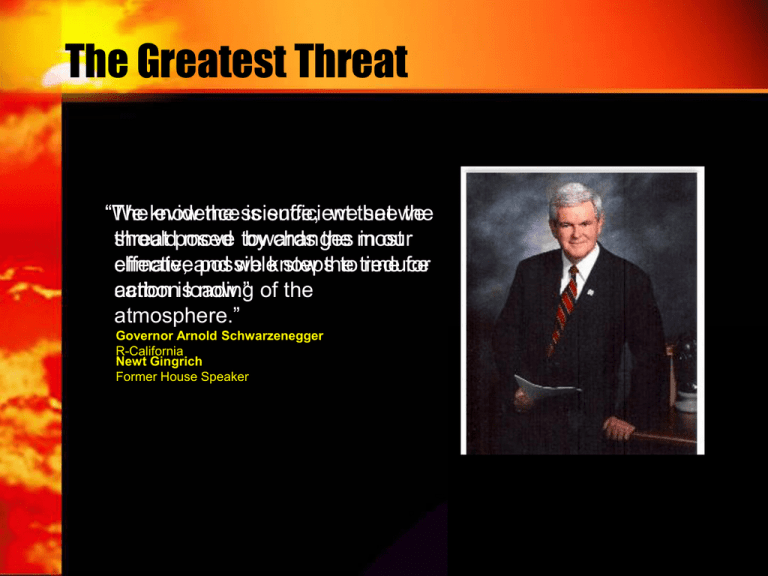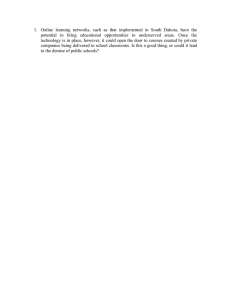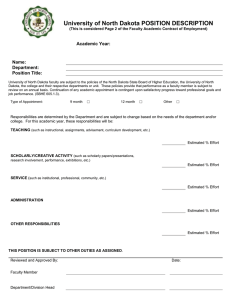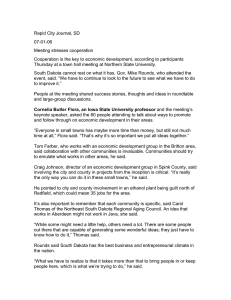North Dakota
advertisement

The Greatest Threat “Theknow “We evidence the science, is sufficient wethat seewe the threat posed should move towards by changes the most in our climate, and effective possible we know stepsthe to time reduce for action isloading carbon now.” of the atmosphere.” Governor Arnold Schwarzenegger R-California Newt Gingrich Former House Speaker Alaska & North Dakota Commonalities Wetlands & ponds* Waterfowl Critical Habitat Cold Water Fish Fish Sticks and other Seafood Winters Robust Renewable Energy Potential Small, innovative, pioneering population Warming ground Important Senators* Alaska Waterfowl Hatch dates have advanced 5 to 10 days since 1982 in all 5 species studied in Yukon Delta NWR. Cackling Hatchlings “Seal level rise, increased storm frequency and intensity and wetland drying will likely cause dramatic changes in waterfowl communities.” -- Julien Fischer, Scientist, USFWS Brandt Geese Aleutian Cackling Geese White Front Goose on Nest Wind Power Wind potential: 1.3 trillion kilowatt hours (100 times the amount of electricity used in ND in 2000). Redefining Progress 2004 Conservation Tillage Carbon Credits Farmers Union enrolled 833,000 acres in North Dakota (equivalent of 320,000 tons of carbon). Bismarck Tribune 4/07 $1.50/acre for no till $2.50/acre for grass $4 to $12/acre for forestry Chicago Climate Exchange Waterfowl -- Scaup Population of these diving ducks appears “to be in peril” (Consensus Report 2006 [CR]). Declined from over 7 million (in 1970s) to 3.39 million (2005) (CR). Record low in 2006 -- 3.2 million (Ducks Unlimited 2007). 70% breed in western boreal forest; fastest rate of decline (94,000 birds per year (1978 to 2005.)) “…declines reflect breeding season events” (CR). 19% wetland loss in Yukon Flats (1985-89 v. 2001-03) Where ponds lose 20% or more surface, decline in scaup food sources (i.e., amphipods, gastropods and chironomid larvae) (Corcoran et. al 2007). Hunting and Angling “In 2001 and 2002, sportsmen and women spent more than $468 million hunting and fishing in North Dakota. Gross business volume, including direct and indirect hunting and angling spending, was $1 billion, supporting than 13,000 jobs.” National Wildlife Federation Existing Impacts in North Dakota “Across the Northern and Central Great Plains, temperatures have risen more than 2o F in the past century… Over the last 100 years, annual precipitation has decreased by 10% in North Dakota.” (National Assessment Synthesis Team 2000/2004) Temperatures in 2006, 3.94o warmer than 30-year benchmark December 2006 – February 2007: 8.94o F warmer than baseline in Fargo. (Fargo Forum 4/07) Existing Impacts in North Dakota “There was a dramatic warming of the ground sometime after the Industrial Revolution….. But it’s in the last decade or two that temperatures have increased at the greatest rate.” Dr. Will Gosnold of University of North Dakota , analyzed 952 boreholes Dr. Gosnald and Shannon Heine recording readings at one of the 952 boreholes sites Future Impacts in North Dakota Dr. Andrei Kirilenko – UND professor, study Region could suffer from: Increase in drought The introduction of new, invasive species that could harm crop yields Reduction in insect species that are integral to ecosystem Carbon Sequestration Coal Gasification: North Dakota to Saskatchewan $10 million/year 8,900 tons/day piped Other projects being explored Bismarck Tribune 4/07 What We Can Do Government Actions Senator Byron Dorgan Energy Efficiency Promotion Act Sets aggressive national goals for reducing gasoline usage by 20 percent by 2017; 35 percent by 2025 and 45 percent by 2030. Expedites New Energy Efficiency Standards for Appliances Promotes Advanced Lighting Technologies Promotes Federal Leadership in Energy Efficiency and Renewable Energy Federal and state fleets of civilian vehicles are required to reduce petroleum consumption by 30 percent by 2016. “Efficiency in buildings,efficiency in appliances, greater efficiency in automobiles by battery technology and electric drive vehicles all of this I think will be very helpful to our country and especially to North Dakota.” Be Heard Global Warming Our future is at risk. Be Heard Write Your Montana Senators Please Act Now Alaska Conservation Solutions http://www.alaskaconservationsolutions.com Ducks Unlimited at http://www.ducks.org/states/21/index.html North Dakota Farmers Union http://www.ndfu.org/ Northern Prairie Wildlife Research Center http://www.npwrc.usgs.gov/ Plains CO2ReductionPartnership http://www.undeerc.org/PCOR/default.asp US Department of Energy ~ North Dakota http://www.fossil.energy.gov/programs/projectdatabase/stateprofiles/2004/North_Dakota.html Dall Sheep “…we’re going to have declining Dall sheep. We’re losing their habitat” Dr. John Morton - Kenai National Wildlife Refuge Dall sheep live exclusively in alpine tundra Due to warmer temperatures, the treeline in the Kenai Mountains has risen at a rate of about 1 meter/year over the past 50 years. Photo: Tim Craig, Wildlife Biologist BLM Muskoxen Population in northern Alaska and Canada declined from approximately 700 to 400 (Pat Reynolds FWS 2007). Risk Factors • Icing events • Lower calf production • Deeper snow • Not highly mobile • Increase in disease e.g. nematode lungworm (able to complete life cycle in 1 years vs. 2 years) (Kutz et. al, 2004) Brown Bears Factors of Concern – Diet Impairment: fish and berries (Kenai Brown Bears – fish 90% of diet vs. black bears 10%) – Hibernation disturbances for reproducing females (Jan-May) • 2 months to implant • Cub growth • Flooding of dens (Sean Farley ADF&G 2007). Reduction in productivity and survival rates followed salmon decline in Kuskokwim (additional research underway) (Steve Kovach FWS 2007). Polar Bear in Peril Largest land or ice predator on earth. Males weigh more than 1200 lbs, 12 ft. long and 50 in. necks. Born in snow dens, weighing about a pound and half Most mobile of all quadrupeds some in excess of 600,00 km2 Feed almost entirely on 2 species of ice seals ringed (90%) and bearded Evolved between 80,000 (fossil record) and 200,000 (molecular genetics) years ago (Steve Amstrup, 2007). Statement of Conscience ANTHC photo “ We as Unitarian Universalists are called to join with others to halt practices that fuel global warming/climate change to instigate sustainable alternatives and to mitigate the impending effects of global warming/climate change with just and ethical responses.” Golovin, September 23, 2005. photo courtesy of Toby Anungazuk, Jr. Extra Pictures



